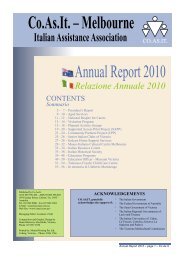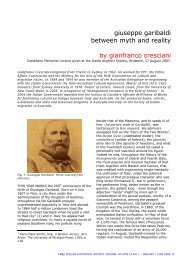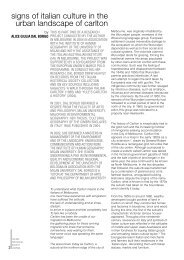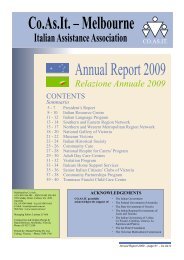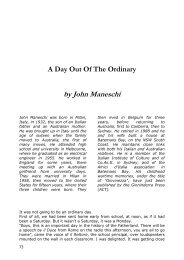January-December 2010, vol. 1
January-December 2010, vol. 1
January-December 2010, vol. 1
- No tags were found...
You also want an ePaper? Increase the reach of your titles
YUMPU automatically turns print PDFs into web optimized ePapers that Google loves.
Australia’s nation-wide state-run distribution system followed a1930s British model. It was created to promote and advertisegovernment policies and as such, documentary films werefreely available for borrowing through workers’ and educationalcircles and were then screened to their members. The creationof state film libraries was triggered by John Grierson’srecommendations to the Australian State Governments in1940. 5 Grierson was the man behind British excellence in thefield of documentary films. Indeed, he was inspired by RobertFlaherty’s Moana (1926), which led him to coin the term‘documentary’ in 1926 and subsequently direct the EmpireMarketing Board (EMB) film unit in 1930 and the General PostOffice (GPO) film unit in 1933.State film libraries were founded immediately after theestablishment of the Australian National Film Board (ANFB) in1945 (which then became ‘Film Australia’ and now is ‘ScreenAustralia’) to promote the documentary idea and the Australianfilms of the ANFB. The ANFB was in charge of supporting anddirecting the production of Australian documentaries, which“signalled the government realisation of the ideological role thefilm may play in national affairs.” 6 The mission of state filmlibraries was to “expand, promote, assist and co-ordinate theproduction, distribution and importation of films for school andadult education, rehabilitation, social development,international understanding, trade and tourist expansion andimmigration” 7 Film became a social tool, a means to promotestate policies, to teach civic and family values, and to foster anew Australian consciousness. This intention is still quite clearlyevident in the 1969 State Film Centre of Victoria pamphlet,“Film with a purpose: documentary film in Australia” whichstates that:... the documentary covers such a wide variety of topics,the youth club, the church group, the union, thebusiness firm, all find that film will work for them, andfarmers will learn about the latest developments ofagriculture through the film; parents’ associations helptheir children by examining childhood problems statedon film. Film helps to combat soil erosion, disease,neurosis, war. Film helps to overcome vandalism, andsimilar social ills. 8Victoria’s State Film Centre (SFC) was established in 1946,became operative in <strong>January</strong> 1947, and was the only Australianstate film library to function as a separate institution and not aspart of an existing State Library. The SFC’s implementation of5 Ina Bertrand et al., Government and film in Australia (Sydney; CarltonSouth: Currency Press, 1981), p. 97.6 Albert Moran, “Constructing the nation: institutional documentariessince 1945” in The Australian Screen, Albert Moran and Tom O’Regan(Ringwood: Penguin, 1989), p. 153.8 State Film Centre, Film with a purpose. Documentary films in Australia(Melbourne: State Film Centre, 1969), n.p.7 State Film Centre, Annual Report 1995-1996 (Melbourne: State FilmCentre, 1996), p. 7.8 State Film Centre, 1969, p. 7.the free distribution system was highly successful. In the periodbetween 1947 and 1957, the number of organisations and filmsocieties registered for borrowing from the SFC grew from 60 to1,500. This represented an increased number of borrowingsfrom 2,074 to 44,000, amounting to an estimated audience of2.6 million viewers in Victoria alone. By 1960, the SFC’s annualreport recorded more than 10,000 titles in its collection, with anaverage increase of more than 700 acquisitions per year. 9Between 1948 and 1980, the SFC “issued a total of 14 New FilmCatalogues” at irregular intervals. 10 Each catalogue containedlists of new films acquired in the period since the publication ofthe previous catalogue, categorised by subject. 11 Thealphabetical subject list corresponds to the library’sencyclopaedic aspiration. In other words, it aimed to promotethrough the films a particular vision of the world and afunctional and rational approach to society. Ranging from ‘AirPollution’ to ‘Community Life’, from ‘International Cooperation’to ‘Sexual Behaviour’, from ‘Australia – Immigrationand Emigration’ (sic) to ‘Libraries and Librarianship’, from‘Philosophy’ to ‘Physiology’, each desired subject headingintroduces a separate area of knowledge documented andsatisfied by the film. Even artistic films became a categoryappearing under ‘Film as an Art Form’ or under ‘Film Directors’.This ideological aspect has now been partially hidden thanks tothe arrival of online catalogues and databases, whereby subjectsearches have been superseded in favour of searches bykeyword, author and title.italian films in the state film centre collectionACMI’s current online catalogue lists 66 Italian-produced 16mmtitles in its collection. This list comprises 7 feature films (3 inItalian language), 26 animation shorts and 33 documentaries.These films are about art (13), music (7), cinema (3), nature (4),sport (2) and international affairs (4). A mere 19 out of 66 are inItalian language with the remainder only available in English. Atimeline of how the collection of Italian films was created isdifficult to determine as ACMI is currently unable to provide theacquisition date of each film. The only available evidence is the‘new film’ catalogues of the State Film Centre. 12Before analysing individual films, it is necessary to consider thispresence of Italian films in the correct context. There are 21,14116mm films listed in the ACMI film collection. Of these,approximately 17,800 were produced before 1978 and werelikely to be in the library at that time. Therefore, the 66 Italianproducedfilms represent, in a best case scenario, only 0.3% ofthe total collection. In the period 1950 to 1979, the number ofItalian-born residents in Victoria increased from 40,000 to115,000 and by 1981, they represented the largest non-English9 State Film Centre, 1996, p. 5.10 State Film Centre, Catalogue of 16mm sound films (Melbourne:State Film Centre, 1979), p. 1.11 Only the 1952, 1954 and 1962 catalogues were available forconsultation to document the actual presence of a title in the collectionin the first 15 years of the State Film Centre collection.12 State Film Centre, 1979, p. 2.IHSJ ITALIAN HISTORICAL SOCIETY JOURNAL VOLUME 18 <strong>2010</strong> | 35





